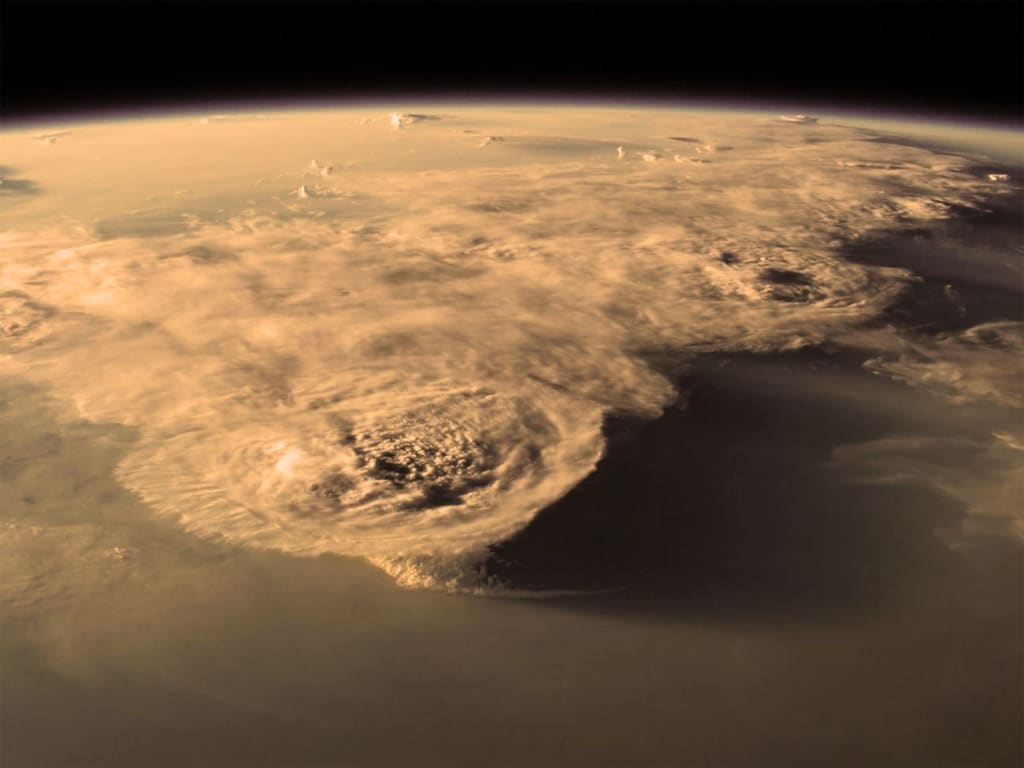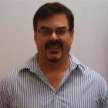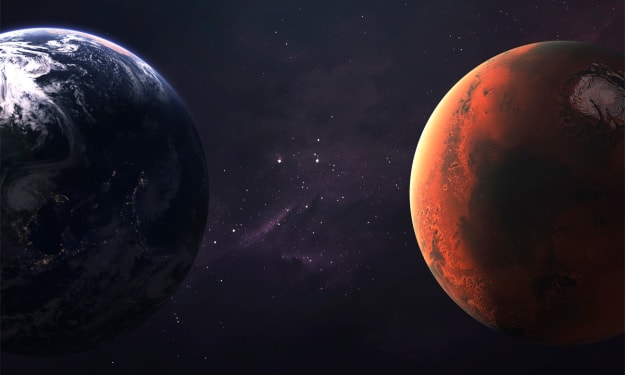Proxima Centauri Extreme Red Shift.
Proxima Centauri

As Captain Chamberlain sat in his vacuum pressure suit on the command bridge, he looked down at the console in front of him gathering his thoughts. Looking up at the main bridge display Chamberlain studied the planet below him. Currently, the planet’s surface was engulfed in heavy cloud cover. Doubts had begun to nag at him as he studied the featureless planet below him. Without a functional navigational system and long-range scanners, the lack of information created severe self-doubt in Chamberlain’s usually decisive mind.
The star Proxima Centauri should be a red dwarf not, the yellow dwarf shining brightly behind them. Further, the planet they were orbiting should have 20% less mass. Something was wrong or UNN Space Command’s calculations were incorrect. Granted, astrophysics calculations could be subject to error from over 4 light-years away but why would they be this erroneous.
As he studied the shifting colors of the planet’s face, he entertained the thought that perhaps they had somehow been diverted off course. Without a functional navigational system or long-range scanners fixing an absolute position would be problematic. Also, system logs remained corrupted contributing to the information deficit. With these troubling thoughts, he realized he needed to file his supplemental log report before the landing party descended to the planet’s surface. Jabbing a graphic on his console he began speaking.
“This is Captain Jonathan Chamberlain of the United Nations Space Command exploratory ship Barrett, submitting supplemental log entry 24068. The Barrett was tasked to explore the Proxima Centauri star system; specifically, the exoplanet Proxima Centauri b. The Barrett launch date was January 5th, 2060. Initially, the Barrett crew complement was 10 with eight surviving crew members: The original crew manifest is embedded in this log entry.
Upon detecting multiple fatal system failures, the ship’s AI system initiated an emergency hypometabolic stasis activation protocol. After surviving crew members had been revived, the crew assumed their stations and performed a manual review of the ship's status and position. Visual scans indicated the Barrett was on approach to a planetary body. All long-range scanner sensors, navigation and, communication systems sustained extensive damage and remain inoperable.
After manually navigating an intercept course for the unidentified exoplanet, the crew successfully established a geosynchronous orbit approximately 190 kilometers above the planet’s surface. I have initiated a shuttle safety review in anticipation of implementing surface landing protocols. The Barrett will remain in orbit with Colonel Khan remaining onboard in command to affect repairs.
Commander Chen and I will descend to the planet’s surface in the landing shuttle. Distinguishing specific planetary surface details is very difficult due to the immense storms clouding the planet’s surface. Commander Chen is reasonably certain the surface winds are within the landing craft’s tolerances and pose minimal danger to the landing party.
I realize implementing surface landing protocols with sensor and non-functional navigational systems violates regulations and procedures. However, I believe exigent circumstances exist justifying my command decision. All crew remaining onboard will continue ship repair to inoperable systems.
Colonel Khan has brought the ship’s fusion reactor online enabling artificial gravity. With reactor power online and stabilized I have ordered the emergency solar sails retracted. Life support is fully functional. The ship’s crew has done an amazing job refitting the ship within the last 36 hours.
This is UNN Starship Captain Jonathan Chamberlain signing off.”
Chamberlain heard a slight clicking behind him. Turning he waited for Commander Chen to sit before speaking. “Commander, something on your mind? If you have any doubts about our field trip, please feel free to voice them now.” Chen looked at Chamberlain and started to answer hesitating before speaking, ”Nothing substantive yet Captain. I find myself in an unusual situation.” Chamberlain looked at his first officer, “What kind of situation?” “I have concerns, but I have incomplete information. ” Chen replied. “Yeah, I know Dr. Chen, I’ve got a bad feeling about this landing as well,” Chamberlain said with a smile. Chen absently nodded her head in acknowledgment. “Ok commander let's saddle up?” Chen looked at Chamberlain in puzzlement. “It’s vernacular from the American old west,” Chamberlain said with a grin, “Let’s board the landing craft and complete the pre-flight.”
As Chamberlain followed Chen down the passageway through the crew’s quarters he briefly stopped in his small personal space and picked up his watch. Passing Chen’s living quarters, he paused at the open door waiting for Chen to reappear. As he waited, he noticed her décor featured pear trees. There was a miniature artificial pear tree and several framed pictures of pear trees in different seasons. Chen turned toward the open door feeling his presence in the passageway. “I like what you’ve done to the place.” Chamberlain quipped, “I see you like pear trees?” Chen blushed slightly, “My family had several pear trees around our home. My father enjoyed their symbolism, and they didn’t conflict with party doctrine.” Chen said.
Chamberlain nodded thoughtfully, “I didn’t realize the pear had such an importance in Chinese culture.” “I’m not sure of the pear’s importance but I remember my father telling me the ancient Chinese believed that the pear was a symbol of immortality. The long-lived pear tree came to symbolize long life and good fortune. In Chinese literature, especially poetry, the destruction of a pear tree also came to symbolize premature or tragic death. yellow pears or pear trees were used to symbolize the gold of good fortune and profit. Also, in Chinese folklore, the pear is used metaphorically to illustrate generosity.” Chamberlain nodded his head in approval, “That seems appropriate for our task at hand. “I thought so,” Chen said agreeing with him.
Chamberlain and Chen left her tiny space and continued aft toward the rear of the ship. Descending a utility stairwell, they faced the sliding doors to the cargo bay where the small shuttle awaited them. Before entering they put on their personalized vacuum suits and completed the obligatory mutual safety check.
After donning their vacuum suits, they opened the second set of doors to the cargo bay and clumsily stomped across the deck at one-third G and entered the confined space of the landing shuttle, and began their pre-launch checklist. Once completed they sat facing the blast doors waiting for compartment decompression. Red lights began to rotate and a sharp beeping in their headsets signaled the cargo bay doors opening. As the doors began to slowly retract the conveyer belt beneath the shuttle’s landing struts began to move the landing shuttle toward the opening created by the receding doors. Khan’s voice came over the ship’s comms. “Captain all systems are nominal. I have the ship’s AI remote controlling the shuttle. The system override is on the lower left of your panel. I would recommend relying on the ship’s AI for the descent unless something goes wrong of course.” “Roger that Commander Khan. ” Chamberlain replied. “Godspeed Captain,” Khan said.
Within minutes thrusters fired, guiding the shuttle gently out of the cargo bay. With a gentle thud, Chamberlain felt the large bay doors close behind them. With a jerk, the shuttle’s main thrusters fired propelling them forward and away from the Barrett. As the shuttle dropped it began to accelerate and jerk slightly as automatic navigational controls maneuvered the shuttle into its correct bearing and re-entry angle as the shuttle hurtled toward the planet’s surface.
Both Chamberlain and Chen drew sharp intakes of breath as they settled into their hypersonic descent toward the planet’s surface. Both officers breathlessly enjoyed the stunning panoramic view of the planet’s surface rushing toward them. “Enjoy the view commander it may be the last….for a while.” Chamberlain joked as heat resistance panels closed covering the viewing windows protecting them from the extreme heat generated by the shuttle’s friction against the planet’s atmosphere.
Within minutes the small shuttle bucked and groaned as it descended into the planet’s lower atmosphere. Chen relaxed back into her seat as Chamberlain disengaged the ship’s AI and took manual control. The familiar action of piloting the craft as it transitioned from a spacecraft to an aircraft relaxed him. Opening the viewer panels allowed both astronauts to view their surroundings. The planet’s ongoing storm had saturated the air around them with fine dust particles limiting any real visibility. Relying on instruments Chamberlain continued their descent, leveling the landing craft at 10,000 meters. “What is your atmospheric readings Commander?” Chamberlain asked Chen. “Atmospheric gases are 73% carbon dioxide, 24% nitrogen 2% oxygen with the remainder being methane, water vapor, and other trace gases,” Chen said quietly.
Chamberlain slowed the craft’s velocity while monitoring his instruments. Chen gazed out at the turbulence outside musing. Suddenly, she blurted out, “When I did my manual position fix earlier today the celestial star placement is remarkably like Earth’s celestial map. Including the placement of local planetary bodies. There were some minor differences. Also, planetary and local star mass calculations are almost identical to Earth and its sun.”
“What?....hold on are you saying what I think you’re saying?” Chamberlain exclaimed. “Are you trying to tell me we’ve arrived at a system identical to our solar system?” Chen shook her head, “No I think we have arrived back at Earth somehow.” Chamberlain shook his head in disbelief, “How can that be?...where is the moon?....there is nothing but a pebble ring around the planet…and the atmospheric gas composition is all wrong. How can you explain no moon or a lack of water and breathable atmosphere?” Chamberlain said.
“Again, without substantive supporting data, I’m just extrapolating,” Chen said. “Ok sorry, please continue,” Chamberlain said.
Chen took a deep breath, “Explaining the moon’s absence could be the result of a collision between the moon and some rogue planetoid. The current atmospheric gas composition along with a lack of liquid water could be the result of some extreme planetary ecological disaster. ” Chen sighed before continuing to speak, “The high level of carbon dioxide could be further evidence of a planetary disaster. I’ve measured a significant reduction in the planet’s magnetosphere indicating a disruption in the planet’s core rotation. A substantial weakening of the magnetosphere combined with a decrease in atmospheric pressure would expose the planet’s atmosphere to solar winds, essentially allowing atmospheric gases to be vented into space.” Chen hesitated before continuing, “In any case, the total collapse of the earth’s environment would be a system cascade failure, not isolated elemental failures. In other words, if one component of earth’s environment failed, the resulting stress placed on the remaining components could lead to a series of Earth’s sub-ecosystem failures, eventually resulting in a complete collapse of planetary ecosystems.”
As Chen finished her explanation Chamberlain slowly descended the craft further seeking an altitude where they could fly in relative safety. Suddenly the fierce winds abated, and visibility cleared enough for them to visually search for a suitable landing area. Both astronauts momentarily lost themselves in their tasks. Chamberlain flying the craft and Chen monitoring her scanners for a landing spot. Suddenly Chen’s scanner momentarily locked onto a structure that did not seem organic. She quickly reviewed her readout and urgently spoke to Chamberlain, “Captain. I think I’ve spotted something on the surface behind us on a heading of 270 degrees, I believe there is an appropriate landing area in the vicinity.” “Roger that Commander, coming about on heading 270 degrees,” Chamberlain responded.
The landing craft shuddered as it reluctantly turned into the wind on their new heading. As they descended, the wind continued to abate. As shadows began to fade with the additional light, both officers drew a sharp breath as the scene below them slowly came into focus. As the ship slowed to a hover, the reality of the sudden recognition of the structure before them shocked both Chamberlain and Chen to their inner core. Directly below them lie the collapsed rubble of the iconic Golden Gate bridge strewn across the arid, desolate opening of what was once San Francisco Bay.






Comments
There are no comments for this story
Be the first to respond and start the conversation.